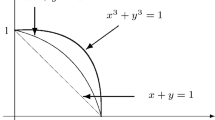Abstract
This paper deals with the problem of defuzzification of a fuzzy number on the basis of decompositional representation that takes into account the strategy of making decisions by a decision-maker (DM). Some advantages of this approach are shown and a method is proposed that increases the level of preciseness of the averaged representative of a fuzzy number with the help of changing weight coefficients of level sets.
Similar content being viewed by others
REFERENCES
A. N. Averkin, Z. I. Batyrshin, A. F. Blishchun, V. B. Silov, and V. B. Tarasov, Fuzzy Sets in Models of Control and Artificial Intelligence [in Russian], Nauka, Moscow (1986).
T. J. Ross, Fuzzy Logic with Engineering Applications, McCraw-Hill, (1995).
U. Hohle and S. E. Rodabaugh (eds.), Mathematics of Fuzzy Sets: Logic, Topology, and Measure Theory, Kluver (1999).
W. Pedrycz and F. Gomide, An Introduction to Fuzzy Sets: Analysis and Design, A Bradford Book, MIT Press (1998).
E. N. Nasibov, Methods of Processing of Fuzzy Information in Problems of Decision Making [in Russian] Elm, Baku (2000).
R. R. Yager, “Knowledge-Based Defuzzification,” Fuzzy Sets and Systems, 80, 177–185 (1996).
T. Calvo and R. Mesiar, “Criteria importance in median-like aggregation,” IEEE Trans. Fuzzy Systems 9, No.4, 662–666 (2001).
T. Calvo and R. Mesiar, “Generalized Medians,” Fuzzy Sets and Systems, 124, 59–64 (2001).
Hsi-Mei Hsu and Chen-Tung Chen, “Aggregation of fuzzy opinions under group decision making,” Fuzzy Sets and Systems, 79, 279–285 (1996).
L. Godo and T. Vicenc, “On aggregation operators for ordinal qualitative information,” IEEE Trans. Fuzzy Systems, 8, No.2, 143–154 (2000).
J. V. Oliveira, “A set-theoretical defuzzification method,” Fuzzy Sets and Systems, 76, 63–71 (1995).
R. Fuller and P. Majlender, “An analytic approach for obtaining maximal entropy OWA operator weights,” Fuzzy Sets and Systems, 124, 53–57 (2001).
M.-G. Chung, “A similarity-based bi-directional approximate reasoning method for decision-making systems,” Fuzzy Sets and Systems, 117, 269–278 (2001).
R. Yager and D. Filev, “On the issue of defuzzification and selection based on a fuzzy set,” Fuzzy Sets and Systems, 55, 222–271 (1993).
D. Filev and R. Yager, “An adaptive approach to defuzzification based on level sets,” Fuzzy Sets and Systems, 54, 355–360 (1993).
M. Ma, A. Kandel, and M. Friedman, “A new approach for defuzzification,” Fuzzy Sets and Systems, 111, 351–356 (2000).
E. N. Nasibov, “Linear transformations with fuzzy arguments,” Izv. Akad. Nauk Az. SSR, Ser. Fiz.-Tekh. Mat. Nauk, No. 6, 164–169 (1989).
E. N. Nasibov, “Some numerical indices of fuzzy numbers,” in: All-Union Sci. Conf. “ Intellectualization of Control Systems,” Baku, 33–34 (1991).
E. N. Nasibov, “Two averaged characteristics of fuzzy numbers,” Deposited at VINITI 14.02.91, No. 772-B91.
E. N. Nasibov, “Some numerical characteristics of fuzzy sets,” Izv. AN AR, Ser. Fiz.-Tekh. Mat. Nauk, No. 3–4, 157–160 (1999).
Author information
Authors and Affiliations
Additional information
This work is supported by the TUBITAK NATO PC-B Program.
__________
Translated from Kibernetika i Sistemnyi Analiz. No. 2, pp. 176–186, March–April 2005.
Rights and permissions
About this article
Cite this article
Nasibov, E.N. Aggregation of Fuzzy Information on the Basis of Decompositional Representation. Cybern Syst Anal 41, 309–318 (2005). https://doi.org/10.1007/s10559-005-0065-0
Received:
Issue Date:
DOI: https://doi.org/10.1007/s10559-005-0065-0




